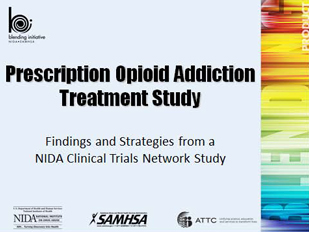Prescription Opioid Addiction Treatment Study (POATS)
 Treatment Strategies for Prescription Opioid Dependence is a package of tools and training resources for substance use disorders treatment providers. The Blending Package describes how buprenorphine works and presents the results of a National Drug Abuse Clinical Trials Network (CTN) study that compared brief and extended buprenorphine treatments. The results of the study have implications for the treatment of adults dependent on prescription opioids. The POATS Blending Team (BT) package is designed to help treatment providers incorporate study findings and recommendations into their practice.
Treatment Strategies for Prescription Opioid Dependence is a package of tools and training resources for substance use disorders treatment providers. The Blending Package describes how buprenorphine works and presents the results of a National Drug Abuse Clinical Trials Network (CTN) study that compared brief and extended buprenorphine treatments. The results of the study have implications for the treatment of adults dependent on prescription opioids. The POATS Blending Team (BT) package is designed to help treatment providers incorporate study findings and recommendations into their practice.
POATS Blending Team Members
NIDA/ NDAT CTN
- Roger Weiss, MD, Harvard Medical School, McLean Hospital
- Hilary Smith Connery, MD, PhD, Harvard Medical School, McLean Hospital
- Joshua D. Lee, MD, MSc, New York University, Langone Medical Center
- Jennifer Sharpe Potter, PhD, MPH, University of Texas, Health Science Center
SAMHSA/CSAT-ATTC
- Thomas E. Freese, PhD, Pacific Southwest ATTC (Co-Chair)
- Beth Rutkowski, MPH, Pacific Southwest ATTC (Co-Chair)
- Leslie Cohen, ATTC of New England
- Traci Rieckmann, PhD, Northwest Frontier ATTC

